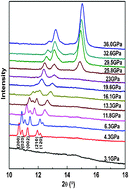Ammonia molecule rotation of pressure-induced phase transition in ammonia hemihydrates 2NH3·H2O
Abstract
High-pressure Raman scattering and

* Corresponding authors
a
State Key Laboratory of Superhard Materials, Jilin University, Changchun, P. R. China
E-mail:
cql@jlu.edu.cn
b CHESS, Wilson Laboratory, Cornell University, Ithaca, NY 14853
High-pressure Raman scattering and

 Please wait while we load your content...
Something went wrong. Try again?
Please wait while we load your content...
Something went wrong. Try again?
C. Ma, F. Li, Q. Zhou, F. Huang, J. Wang, M. Zhang, Z. Wang and Q. Cui, RSC Adv., 2012, 2, 4920 DOI: 10.1039/C2RA01156E
To request permission to reproduce material from this article, please go to the Copyright Clearance Center request page.
If you are an author contributing to an RSC publication, you do not need to request permission provided correct acknowledgement is given.
If you are the author of this article, you do not need to request permission to reproduce figures and diagrams provided correct acknowledgement is given. If you want to reproduce the whole article in a third-party publication (excluding your thesis/dissertation for which permission is not required) please go to the Copyright Clearance Center request page.
Read more about how to correctly acknowledge RSC content.
 Fetching data from CrossRef.
Fetching data from CrossRef.
This may take some time to load.
Loading related content
